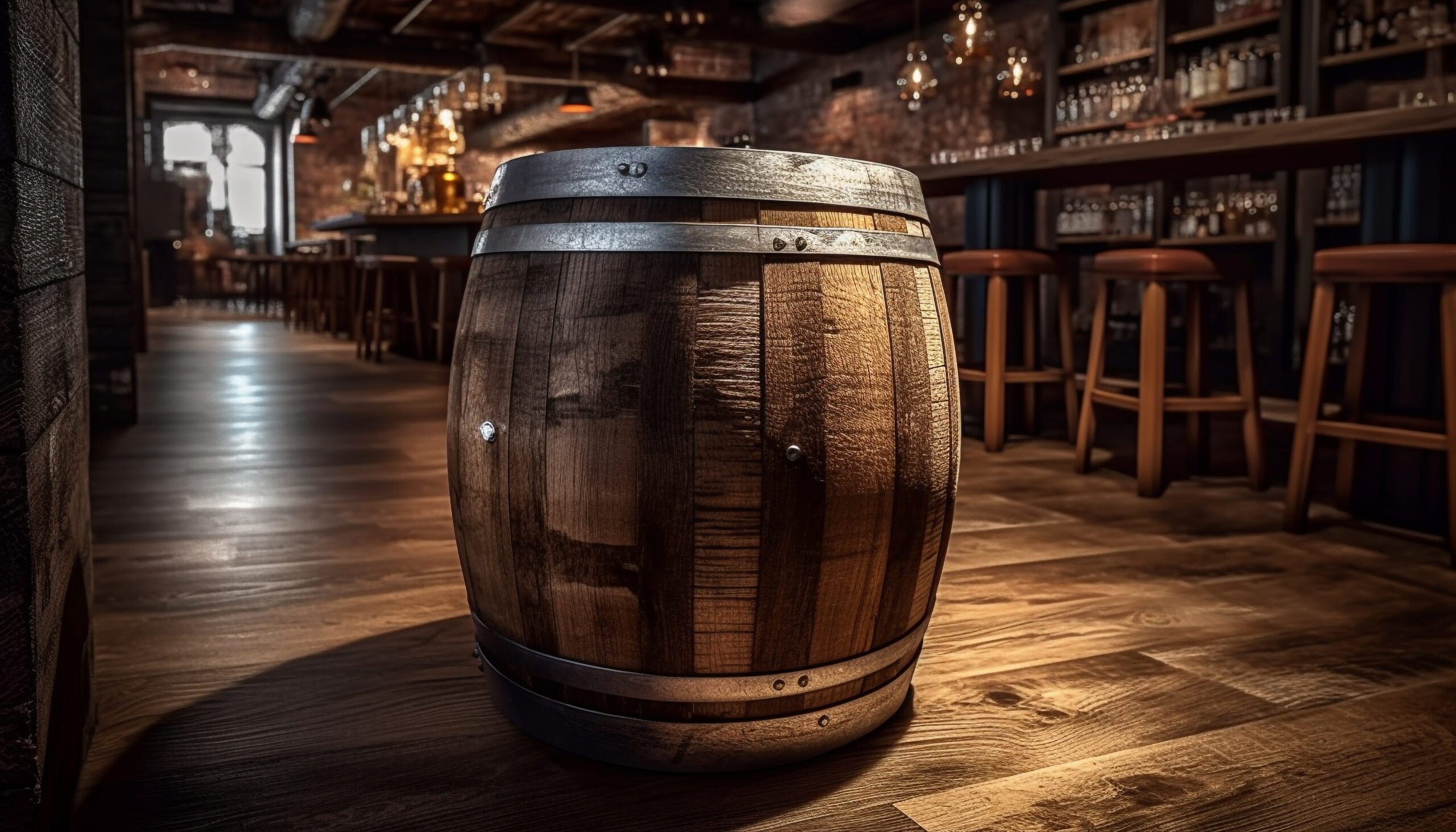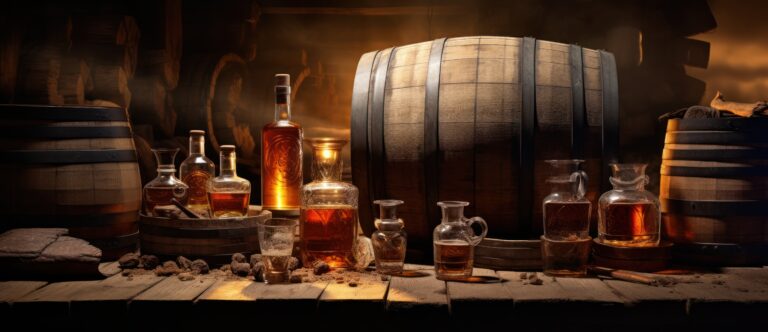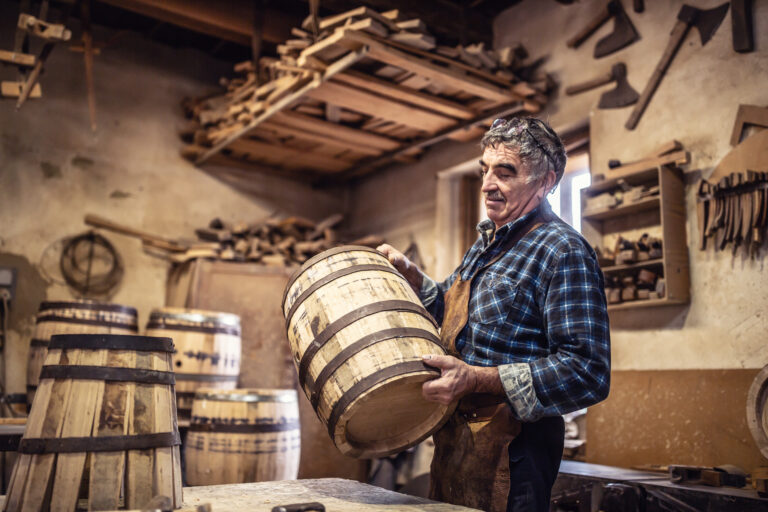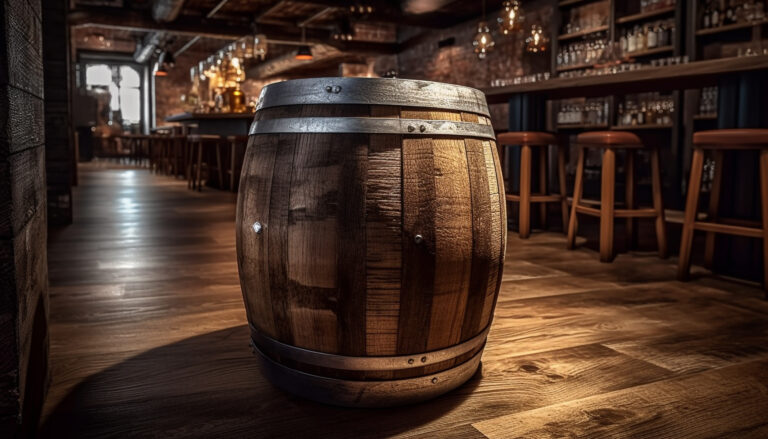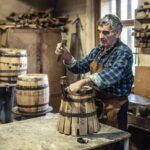Ever wondered how much golden goodness a single whiskey barrel can hold? If you’re anything like me, a casual whiskey enthusiast, your immediate thought is probably, “A ton!” But have you ever truly paused to consider the actual liquid volume nestled within those iconic wooden barrels? It’s more than just “a lot,” trust me. While barrels come in a few standard sizes, the real workhorses for aging whiskey typically cradle a robust 53 gallons, or a neat 200 liters. Talk about a serious stash of whiskey! For those who love a good number, that’s roughly equivalent to 950 standard whiskey bottles in just one barrel. Mind-blowing, right?
What Exactly Is a Whiskey Barrel, Anyway?
At its heart, a whiskey barrel is a specially crafted, charred oak container designed not just to hold, but to transform whiskey through the aging process. While they commonly hold 53 gallons, you’ll find some delightful variations in size.
Initially, barrels were simply practical vessels for moving goods around. But then, a stroke of genius (or perhaps happy accident) led distillers to realize that aging whiskey in these charred barrels dramatically enhanced its flavor. The charring isn’t just for show; it actually caramelizes the wood’s natural sugars and creates fascinating compounds that directly impart incredible flavor to the whiskey.
Interestingly, American whiskey barrels are usually hewn from American white oak, while Scotch whisky barrels have a long-standing tradition of using European oak. This choice of oak type, alongside the intensity of the char and even the terroir where the oak grew, all play a starring role in shaping the final taste profile of the aged whiskey.
The design of a whiskey barrel – its size and distinctive shape – isn’t random. It’s meticulously optimized for both the aging process and for ease of transportation. Their classic rounded shape maximizes the internal volume while still allowing them to be rolled by hand – a surprisingly efficient method! And those oak staves? They’re constantly expanding and contracting with temperature shifts, allowing the barrel to “breathe” and intimately interact with the whiskey inside.
Ultimately, a barrel’s purpose transcends mere storage; it’s a vessel of profound transformation. As whiskey ages within its embrace, it diligently absorbs beautiful color and complex flavor notes from the wood, slowly mellowing into that rich, amber-colored spirit we all adore. This intricate art of barrel-aging is truly what bestows upon each whiskey its unique and unforgettable taste and aroma.
So, while a whiskey barrel might seem like a straightforward piece of craftsmanship, it’s absolutely fundamental to creating a premium whiskey. The synergistic magic of the wood and the char turns clear distillate into liquid gold. For dedicated whiskey lovers and skilled whiskey makers alike, the humble barrel truly reigns supreme.
Getting Down to Brass Tacks: Standard Whiskey Barrel Sizes
When we talk about whiskey barrels, size is definitely a significant factor. Here’s a peek at the common barrel sizes you’ll encounter in the whiskey industry:
- 53 gallons (approx. 200 liters): This is the undisputed champion, the most common size, and the go-to for aging bourbon and Scotch whisky. Expect it to yield around 250 standard whiskey bottles.
- 63 gallons (approx. 238 liters): A slightly larger contender, still frequently used for aging whiskey, holding roughly 295 bottles.
- 114 liters (equivalent to about 30 gallons): You’ll often see these smaller barrels adopted by craft distilleries for smaller batch aging, offering a different aging dynamic.
The barrel’s size profoundly influences the whiskey aging process and its flavor development. Think of it this way: a larger barrel means a lower surface area-to-volume ratio, which translates to a slower, more deliberate aging process for the whiskey. Conversely, those smaller barrels offer faster aging and increased interaction with the wood, leading to an accelerated infusion of flavor. Many clever distillers strategically employ a mix of barrel sizes to achieve that perfect, nuanced blend of flavors in their whiskey.
So, the next time you savor a glass of that beautiful, golden-brown elixir, take a moment to appreciate the incredible time and meticulous care that went into aging it to perfection. The unassuming whiskey barrel might seem minor, but it’s undoubtedly one of the most vital tools in any distiller’s arsenal. When it comes to crafting genuinely quality whiskey, size truly does matter.
Just How Much Liquid Can a Barrel Really Hold?
A standard whiskey barrel is quite the spacious container! As we’ve discussed, the most common sizes are the standard 53-gallon (or 200-liter) barrel and then the smaller range, typically from 5 to 30 gallons. To put things in perspective, a gallon of water weighs about 8 pounds. So, a completely full 53-gallon barrel would tip the scales at over 400 pounds! That’s some serious weight!
And How Much Whiskey Are We Talking About?
After the entire aging process, a 53-gallon barrel will typically yield somewhere between 150-200 standard whiskey bottles (750ml). The precise amount of whiskey that makes it out of a barrel depends on a few key factors: the barrel type, the length of aging, and the initial alcohol percentage. Keep in mind that a significant portion of the liquid simply evaporates over time (the “angel’s share,” which we’ll get to!), meaning less liquid ultimately emerges from the barrel.
Beyond Whiskey: What Other Liquids Find a Home in Barrels?
It’s a common misconception that whiskey barrels are only for aging whiskey. Far from it! They’re incredibly versatile and frequently used for aging and storing a delightful array of other liquids:
- Wine
- Rum
- Brandy
- Beer (especially craft brews!)
- Maple syrup
- Hot sauce (yes, seriously!)
- Vinegar
- And many, many more!
Barrels inherently impart wonderful flavor, color, and aroma compounds to whatever liquid they house. The interaction between the wood and the product inside genuinely enhances it, especially over extended aging periods. This is precisely why barrel-aged spirits, wines, and ciders consistently boast more complex and intriguing flavor profiles.
So, whether your passion lies in aging whiskey, wine, beer, or even that super-spicy hot sauce, a standard whiskey barrel offers ample space for your creative concoctions. The longer you let it age, the more those rich wood flavors will permeate, so remember to sample frequently to hit that perfect sweet spot between wood and spirit. Your patience, I promise, will be richly rewarded!
What Makes a Barrel’s Capacity Tick? Factors at Play
The ultimate size and capacity of a whiskey barrel aren’t arbitrary; they’re influenced by several fascinating elements. The type of wood used, the thickness of the staves, and the overall shape of the barrel all play a part in determining just how much liquid it can comfortably hold.
Generally, American oak barrels tend to be on the larger side, typically ranging from 53 to 63 gallons. Barrels crafted from European oak, on the other hand, are usually a tad smaller, hovering around 50 to 55 gallons. Interestingly, thicker staves allow for less leakage, meaning barrels made with sturdier wood can often be built to be larger.
The barrel’s shape is another crucial factor. Wider barrels inherently hold more liquid than their taller, narrower counterparts. You might also encounter barrels that bulge quite significantly in the middle, affectionately known as “port pipes”; these beauties offer increased capacity. Some distillers even prefer these unique shapes for aging specific whiskeys.
It’s also worth noting that the charring process inside the barrel actually reduces its internal volume. More heavily charred barrels inevitably lose more space, so they might start out slightly larger to compensate. While the char is essential for imparting flavor to the whiskey, it does claim some of that precious internal room.
Even the weather conditions during aging have an impact! The barrel will subtly expand and contract with temperature changes, which affects its size over time. It’s not uncommon for whiskey barrels to gain or lose up to 10% of their volume during the entire aging process. Experienced distillers always factor this in when they first fill the barrels.
Ultimately, numerous elements contribute to how much whiskey a barrel can hold. But at the end of the day, a barrel’s capacity is all about striking that perfect balance between maximizing volume and, more importantly, crafting a truly full and complex flavor profile. When it comes to aging great whiskey, bigger isn’t always better.
The Magic Touch: How Barrels Sculpt Flavor
The aging process within whiskey barrels has an absolutely monumental impact on the final flavor of the whiskey. As the whiskey patiently rests inside those charred oak barrels, it relentlessly absorbs incredible flavors and captivating aromas directly from the wood. And here’s the golden rule: the longer it ages, the more intricately complex those flavors become.
The Art of Charring the Barrels
The inside surface of these barrels undergoes a crucial process called charring, which means they’ve been exposed to an intense open flame. This charring isn’t just for show; it’s a masterful technique that helps the whiskey absorb more of those desirable flavors from the wood. The char creates tiny cracks and crevices, inviting the whiskey to seep in and pull out delightful notes like vanilla, rich caramel, and intriguing spice. The level of char directly dictates how much flavor is imparted – a more heavily charred barrel will result in more robust and intense flavors.
The Wood Itself: A Flavor Alchemist
The very type of oak used for the barrels is another critical flavor influencer. American white oak is the reigning champion for bourbon barrels. It’s responsible for gifting bourbon those signature flavors of coconut, sweet maple syrup, and warming cinnamon. European oak, often employed for Scotch whisky, tends to contribute more distinct dried fruit notes. Even the age, grain, and geographical location of the oak trees themselves make a discernible difference in the flavor compounds that ultimately shine through in the final spirit.
The Masterstroke: Blending Barrels
Behind every exceptional whiskey often lies the skillful hand of a master distiller, who will meticulously blend whiskeys from various barrels to achieve that desired, harmonious flavor profile. By thoughtfully combining barrels of different ages, varying char levels, and even diverse wood types, they can craft a truly complex and beautifully balanced spirit. The art of blending barrels is, without a doubt, a cornerstone of creating truly exceptional whiskey.
The “Angel’s Share”: A Divine Evaporation
As the whiskey ages gracefully in the barrels, a small amount of the liquid inevitably evaporates – a phenomenon charmingly known as the “angel’s share.” On average, about 2-5% of the barrel’s contents disappear each year. This natural concentration effect further amplifies the whiskey’s flavor over time. The longer it’s left in the barrel, the more pronounced and intense the flavors become as the volume gradually reduces.
Inside the Barrel: The Aging Process Unveiled
The intricate aging process that unfolds within the barrel is the very essence of what gives whiskey its distinctive and captivating flavor and aroma.
The Wood: More Than Just a Container
As mentioned, the interior of the barrel is charred, deliberately exposed to an open flame. This charring process is magical, releasing compounds from the wood that directly impart flavor to the whiskey. The wood type, almost exclusively oak, also contributes its own signature notes of vanilla and spice.
As the whiskey patiently rests, it diligently soaks up these incredible flavors from the wood. The longer it ages, the more layered and complex its flavors become. Many astute distilleries even reuse barrels that have previously held bourbon, sherry, or port wine. The delightful remnants of these liquids, lingering within the wood, add fascinating extra layers of flavor to the developing whiskey.
Evaporation: The Angel’s Contribution
A small but significant amount of the whiskey gently evaporates during aging – that renowned “angel’s share.” This natural evaporation concentrates the remaining whiskey, intensifying its flavor and aroma compounds. After several years of aging, a barrel might lose anywhere from 5-10% of its initial volume due to this ethereal process.
Oxidation: The Slow, Steady Transformation
Through the semi-porous wood, the whiskey experiences a slow and steady exposure to oxygen, leading to gradual oxidation over time. This oxidation is crucial; it produces new flavor compounds that can imbue the whiskey with delightful smoky, nutty, or spicy notes. The oxidation process is meticulously controlled during aging to achieve that perfect, exquisite balance of flavors.
Whiskey connoisseurs frequently describe well-aged whiskeys as smooth, mellow, or beautifully well-rounded. These cherished characteristics are born from the magical transformation that occurs during the aging process inside the barrel. Time, the remarkable properties of wood, the gentle dance of evaporation, and the subtle influence of oxidation all conspire to create an truly exceptional aged spirit.
Beyond Oak: Exploring Different Woods for Barrels
While oak reigns supreme, it’s not the only wood that finds its way into whiskey barrels. Here are some of the more common and intriguing wood types used:
- Oak (The King!): This is the undisputed monarch of barrel woods. Oak barrels, particularly those crafted from American or French oak, consistently impart delectable vanilla and caramel flavors to the whiskey. Oak is also perfectly porous, allowing just enough oxygen to enter and gently mellow the spirit.
- Hickory: Less common, but favored by some adventurous distillers. Hickory barrels tend to lend intriguing nutty, even smoky notes. Being a denser wood, it typically results in less oxidation.
- Maple: Primarily embraced by craft distillers across the US and Canada. Maple barrels contribute subtle, lovely maple syrup flavors. The tight grain of maple means less interaction with oxygen.
- Ash: Not widely used, but ash barrels can produce whiskey with distinct floral aromas. However, ash barrels are more prone to leaking due to pores in the wood that whiskey can seep through.
- Chestnut: Once incredibly popular, but now quite rare due to a blight that decimated American chestnut trees. Chestnut barrels were known for lending a slight nuttiness and a pleasing tannic character, resulting in a more mellow and smooth whiskey. Excitingly, some distillers are bringing chestnut barrels back into play using reforested chestnut wood.
Ultimately, the choice of wood type boils down to the specific flavor profile the distiller is striving to achieve. Oak, and particularly American white oak, remains the most popular choice because of its ideal ability to profoundly influence the whiskey’s taste and aroma over time. But for the truly adventurous, experimenting with other wood varieties can unlock a universe of exciting new tastes. The possibilities for barrel experimentation are, quite frankly, endless!
Fun Tidbits: Charming Facts About Whiskey Barrels
Barrels are far more than mere containers; they are pivotal to the entire whiskey aging process. The barrel size and the type of wood used can dramatically shape the flavor, aroma, and even the color of the final whiskey.
White oak is the undisputed champion when it comes to wood of choice for whiskey barrels. It strikes a perfect balance: incredibly durable yet sufficiently porous, allowing the whiskey to absorb and impart flavor. The crucial charring of the barrel’s interior acts as a natural filter, helping to mellow and refine the whiskey.
A standard whiskey barrel comfortably holds 53 gallons, which is enough to age a generous 250 standard whiskey bottles. And here’s a cool fact: barrels are wonderfully reusable! A single barrel can be employed to age whiskey for an impressive span of up to 60 years before it finally needs replacing. Talk about longevity!
The very location and climate where barrels are aged profoundly influence the whiskey’s character. Colder climates, like the misty regions of Scotland, tend to produce lighter, often fruitier whiskies. Warmer areas, such as Kentucky’s bourbon heartland, typically yield darker, spicier whiskies. The barrels themselves are dynamic; they expand and contract with temperature fluctuations, allowing the whiskey to absorb even more flavor from the wood.
One of the most intriguing aspects is the “angel’s share” – the contents of a barrel steadily decrease over time due to evaporation. This loss averages about 2% each year. Despite this “loss,” the barrel’s contents become incredibly more concentrated and flavorful as water gracefully evaporates. By the time it’s finally bottled, nearly half of a barrel’s original contents may have vanished into thin air!
These are just a few captivating insights into the vital role barrels play in producing and aging our beloved distilled spirit. So, the next time you take a sip of whiskey, spare a moment to ponder the long, flavorful journey it undertook inside those magnificent charred oak barrels.
FAQ: Your Burning Whiskey Barrel Questions, Answered!
How big is a standard whiskey barrel?
A typical whiskey barrel holds 53 gallons or 200 liters. While barrels do come in various sizes, the 53-gallon standard is the most common for aging bourbon and other whiskies.
How much whiskey can you actually get from a barrel?
You can expect to yield approximately 150 to 200 (750 ml) bottles of whiskey from a single 53-gallon barrel. The exact amount can vary based on factors like the type of whiskey, the barrel char, the prevailing climate, and, crucially, the length of aging.
How long does it take to age whiskey?
Whiskey can age in barrels anywhere from a mere 2 years to an impressive 50+ years! Bourbon, by law, must be aged for at least 2 years, though 4-6 years is more typical for quality examples. Scotch and Canadian whiskies are often aged for 3-15 years, or even longer. Generally, the longer a whiskey ages, the more complex and developed its flavor profile becomes.
What magical transformation does the barrel perform on the whiskey?
Barrels are the alchemists! They impart flavor, aroma, and color to whiskey as it ages. The charred oak barrel actively interacts with the whiskey, generously contributing delectable vanilla, rich caramel, and intriguing spice flavors. The barrel also facilitates that essential evaporation (the “angel’s share”), which concentrates the whiskey’s flavor and aroma compounds, making it even more potent and delightful.
Why are whiskey barrels made specifically of oak?
Oak is the preferred wood for several compelling reasons: it’s naturally watertight, incredibly plentiful, and, most importantly, it intrinsically contains compounds like tannins, lignins, and lactones that are absolutely vital for imparting flavor and color to the whiskey. Furthermore, oak is perfectly porous enough to allow controlled amounts of evaporation and oxygenation during the aging process. White oak, both American and French varieties, is universally favored for its superior qualities.
Hope these answers shed some light on your basic questions about whiskey barrels! Don’t hesitate to ask if anything else comes to mind.
Final Sips: Appreciating the Barrel’s Journey
So, there you have it! Now you’ve got a much clearer picture of just how big a whiskey barrel truly is and a real sense of the remarkable volume of liquid gracefully stored inside those iconic brown casks. It’s quite astonishing, isn’t it, just how much whiskey can be so meticulously aged and beautifully mellowed within a single barrel? The next time you take that first delightful sip of your favorite bourbon or Scotch, you’ll undoubtedly possess a newfound appreciation for the incredible care and masterful craftsmanship that goes into producing and aging that precious spirit. Imagine all those years of patient waiting as the whiskey intimately interacts with the wood, slowly but surely developing into that complex, flavorful final product. It’s truly an art form, wouldn’t you agree? And all of this magic, housed within those unassuming yet utterly iconic oak barrels – as mysterious as they are essential. It’s the perfect, harmonious blend of craft, science, and time-honored tradition. And frankly, that’s not a bad combination at all.
